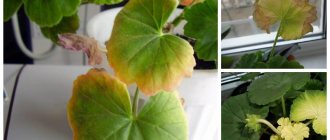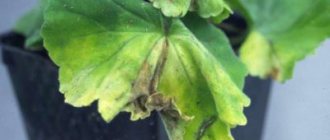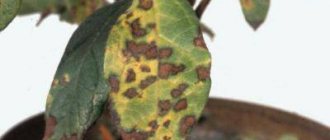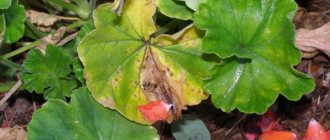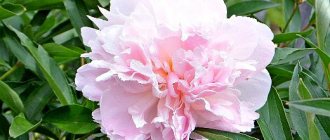So, the most harmless situation is when the leaves of a purchased rose dry out and fall off. Everything is clear here; this bush is going through a period of acclimatization. In flower shops he had completely different conditions: the air was not so dry, and they were stuffed with fertilizer for abundant flowering to the delight of customers.
In the first few weeks, the flower will adapt to its new place of residence and may even partially shed its leaves. You don’t need to do anything with it, just put the pot in a bright place and water it periodically. After some time, the bush will get used to it and repair itself.
A purchased rose must be trimmed immediately after bringing it home, shortening the branches to 5 buds.
More serious reasons for roses drying out may be:
- errors in care;
- presence of pests;
- disease.
Why does an indoor flower in a pot disappear?
The most common causes of death of indoor roses include:
- lack of moisture (perceived especially painfully when there is a lack of microelements and humus in the soil);
- high lime content in the soil;
- excess moisture in the soil (often due to improper drainage or lack thereof);
- lack of sunlight;
- diseases (such as cancer or rust);
- pests (for example, insect larvae).
Rules of care
- Once you have bought a rose bush you like and brought it home, do not rush to replant it. Place the plant on an east or southeast window and let it get used to the new microclimate.
- Roses are watered as often as the soil dries out. Watering is carried out with settled (at least 24 hours) ordinary tap water at room temperature.
- Roses respond well to spraying their leaves. Spraying of roses is carried out in the evenings with cold boiled water or a solution of special fertilizers in cold boiled water. The underside of rose leaves is sprayed with a spray bottle that produces a misty spray. But you shouldn’t spray roses every day, even in summer.
- As soon as the moon enters the growth phase, it is a good time to replant the plant. Transplanting roses from a container into a pot must be done carefully - without destroying the clod of earth or disturbing the roots. There are often white or gray granules of complex fertilizer on the roots of roses; these do not need to be removed or washed off. Before replanting, remove a small amount of old soil from the top of the earthen clod, carefully loosening and removing it without damaging the roots.
- Roses need nutritious soil for good growth: a mixture of 4 parts turf, 4 parts humus soil and 1 part sand. When planting, granules of complex fertilizer must be added to such soil. If you do not have the opportunity to prepare the necessary components for the soil mixture, then roses can be planted in ready-made purchased soil.
- A new rose pot should be larger than the container in which the plant was sold, at least 2-4 cm in diameter and 5-7 cm in height. You shouldn’t take a pot that’s too big either; The above-ground part of the plant should correspond to the volume of the pot as 1:1. If the pot is ceramic and completely new (nothing has grown there yet), then before planting the roses it is first soaked in warm water for 2 hours (this is especially necessary if the pot is unglazed). If something has already been grown in a pot, wash it well with a stiff brush in warm water, but without soap.
- A drainage layer (preferably expanded clay) about 1 cm thick is placed on the bottom of the pot prepared for transplanting the rose. If the pot does not have a drain hole (and it is impossible to make this hole), then the drainage layer should be at least 3 cm. Earth mixed with fertilizer granules, then sprinkled with a layer of soil without fertilizer.
When can a plant not be saved?
If the flower has completely dried out, or the vast majority of its roots have rotted, no resuscitation will help it. The prognosis is also disappointing if the plant is entirely affected by mold or pests. In these situations, it is necessary to dig up and dispose of the affected plant to prevent infection and death of neighboring plants.
If measures to resuscitate the flower do not have an effect, you need to carefully dig up or pull the plant out of the pot and inspect its roots. If the roots are severely damaged by pests or rot, a final measure can help - pruning all old and affected shoots from the bush, which will facilitate its restoration. It is pointless to cut off dead roots, since it is impossible to restore them .
Care errors
Symptoms. The rosette dries up, sheds its leaves, the buds wither, the ends of the shoots turn brown and dry out.
Cause. Insufficient watering, low air humidity.
Treatment. Cut off all dead branches to a height of 3-4 cm from the main trunk, as well as all dry twigs and yellowed leaves. Water the rose, place the pot under a plastic bag to ensure high air humidity under the shelter. When new shoots appear, begin to ventilate the greenhouse and accustom the rose to dry air. If the rose has wilted but not shed its leaves, try soaking the entire pot in water for 5 minutes and spraying the plant, or even soaking the whole plant in a bathtub for 2 hours, wrapping the pot in a plastic bag. If symptoms appear in the fall, don't worry—the rose is preparing for winter.
Symptoms. The rosette dries up, sheds its leaves, the buds wither, the shoots turn brown and rot.
Cause. Too much watering, frequent spraying in a cold room.
Treatment. It is more difficult to revive a rose that has been “overwatered” than “underwatered.” You need to remove it from the pot, clean the roots from the soil and inspect them - if not all of them are rotten, cut off the damaged ones and replant the rose in new soil (the old one may be sour), water it moderately, but not allowing the coma to dry out completely.
What to do to prevent recurrence of problems?
In order to prevent disease or death of roses, it is necessary to follow certain preventive measures. First of all, do not neglect compliance with the rules of agricultural technology. If the plant is affected by mold or pests, proper care will help reduce damage to the flower.
In flower shops, plants in pots are fertilized with special fertilizers that maintain their beautiful marketable appearance. Also, in the room where flowers are displayed, acceptable air humidity is constantly maintained. Therefore, getting from the favorable conditions of a flower shop to less favorable apartment conditions, an indoor rose may become less attractive, fade or get sick (what should be the care of a rose after purchasing it in a store?).
It is recommended not to allow negligence in care , even if the plant is in full health. Moreover, caring for an indoor rose is simple and does not require much time. Regularly pay attention to your plants and respond to symptoms of illness in a timely manner.
By following these simple tips and recommendations, you can help your indoor roses and extend their life. With proper care and sensitivity, this plant can delight you with its magnificent flowers for a long time.
How to cure a rose
You can revive roses after illness using a few tips:
- Place a stand 10 cm high in a basin. Place a flower pot on top, slowly pour boiling water into the basin, make sure that the water does not reach the shoots, steam the plant in such a bath until the water cools completely;
- It would be good to spray a room rose with mineral water;
- put the flower pot in a cool place at about 15-17 ° C for several days.
How to save an indoor rose in winter, when there is little sunlight and the days are short?
It is necessary to provide the flower with additional lighting. Install fluorescent lamps above the flowers and turn them on in the evening.
The soil in the pot should always be moist, the plant loves water, and in winter, when the batteries are turned on, the air in the room becomes dry and the soil gives up moisture faster. Do not forget about daily spraying with cool, settled water.
Poor nutrition
For lush flowering, the rose needs regular feeding with complex mineral preparations. If the flower is not fed, especially in poor soil, the bush will drop leaves and buds in order to survive. However, fertilizers should be used very carefully, avoiding overdose. An increased concentration of minerals is also harmful to any plants.
Drying buds and falling leaves may indicate an excess of nitrogen in the soil, as a result of which the rose simply burns.
Tips and recommendations from experienced flower growers and summer residents
- When starting to grow roses, you need to decide on the type and variety.
- Properly selected seedlings are of great importance for growing healthy and beautiful roses.
- You need to choose bushes with green, elastic stems and smooth, spotless bark.
- High quality seedlings must have at least three shoots.
- They are sold with an open root system, and with a closed root system in containers.
- Frail roses with a poorly developed root system may freeze when planted in the fall.
- Rose seedlings in containers can be planted on cool days of summer.
- The best soil for roses is slightly acidic or neutral.
- Roses take root deeply, so to plant seedlings you need to prepare a hole no smaller than 60 cm.
- Roses are planted when the soil has warmed up from mid-April to mid-May, and in mid-October.
- Before planting, seedlings should be prepared. Long roots are trimmed a little, dry ones are removed.
Important! Thread-like roots should not be touched.
Before planting, seedlings are soaked in water for several hours. Fading inflorescences are cut off without waiting for them to completely wither. This stimulates them to form new flower stalks. The soil near the bush must be constantly loosened and weeds removed in a timely manner so that they do not take nutrients from the soil.
To grow beautiful roses, you need to pay attention to them and follow the recommendations when planting and caring for them. Blooming roses will decorate any garden and bring joy. The most beautiful roses are those that are grown with your own hands.
Yellowing of roses due to lack of nutrients in the soil
The beginning of yellowing or falling leaves can be explained by a lack of useful elements in the soil. The most important substances that influence the development of culture include the following:
- Iron
A deficiency of this substance provokes the development of chlorosis. With this disease, the foliage becomes yellow, decreases in size and curls.
To cope with the problem, it is worth using products such as Ferrilene, Ferovit. The ampoule of the composition must be mixed with water and sprinkled on the plants.
- Nitrogen
This product is responsible for the condition of the green mass. A deficiency of the element provokes blanching of the foliage and its gradual yellowing.
Roses have a special need for the element in the spring. In this case, you need to add ammonium nitrate. It is also permissible to use a combined composition.
For reference! It is worth considering that excess nitrogen can cause fungal pathologies, which negatively affects the condition of the bushes.
- Potassium
If there is a lack of this element, the edges of the leaves dry out in the plant. At the same time, the veins remain green. After a certain time, the leaf blades turn completely yellow and turn red-violet.
The rose should be fed with potassium magnesia. A large amount of potassium provokes developmental delays.
- Manganese
Affected foliage acquires a yellow tint between the veins - from the edges to the central part. A green border appears around the veins. In this case, only old leaves turn yellow. The rose needs to be fertilized with manganese sulfate and the soil deoxidized. You can add peat to it. Ammonium sulfate will also work.
- Magnesium
If there is not enough of this substance, dark red spots appear between the veins. The edges of the leaves remain green. At the same time, they are observed to fall off.
To avoid such problems, you need to regularly add ash to the soil. Magnesium sulfate will also work. In this case, the increased content of the substance provokes a violation of the absorption of potassium.
Insufficient application of fertilizers provokes the appearance of a yellow border on the foliage.
Description and photos of varieties
Room
The indoor rose is miniature, and its compact planting allows you to grow the plant even in a small space. The leaves, like those of ordinary roses, are distinguished by a dark green color and a carved edge. The rose begins to bloom in the spring and continues to please the eye until late autumn, and then a period of slow growth begins.
Decorative garden
Street roses can grow both in bushes and in pots. The option in pots is optimal because the plant can be brought indoors or onto the veranda for wintering. The plant, planted in open ground, is a shrub that can reach up to two meters in height.
Flowers are usually collected in inflorescences of several pieces, and the number of petals does not exceed thirty. Flowering begins in May - July and continues until the onset of cold weather. At this time, the bushes need to be pruned.
Our portal has other information about roses:
- How to save from spider mites?
- Why do the stems and other parts of the plant turn black?
For what reasons do chlorophytum leaves turn yellow and how to treat it?
Many home plant lovers have chlorophytum in their collection. It is worth considering in more detail why the leaves of this plant turn yellow and how to treat it.
Chlorophytum is one of the plants that is quite easy to care for. Experts note that if the flower is cared for correctly, it pleases its owners with lush green leaves. If for some reason the conditions for growing a flower change, this may lead to the fact that it will begin to grow worse.
It is worth paying attention to the most common reasons
A fairly common reason that causes the leaves of this plant to turn yellow is a decrease in air humidity in the room. Dry air is usually a consequence of turning on heating appliances.
Many lovers of indoor plants note that chlorophytums usually dry only in winter, when the heating is on, and quite often yellowing and dryness are noted on the edges of the leaves.
Incorrect temperature is another reason that can lead to changes in leaf color. If this indicator significantly exceeds +26 degrees, then the flower may begin to dry out. Such changes occur due to the fact that the plant, in unfavorable conditions for it, begins to actively evaporate moisture. This in turn leads to the cell membranes of the leaves being damaged. This is manifested by yellowing of the foliage.
Insufficient supply of biologically active substances is another possible reason leading to plant damage. Experts note that if the soil for this indoor flower was initially selected incorrectly, then later in the active growing season it will not have enough necessary substances for good growth.
That is why experts recommend using special additives - fertilizing - in case of yellowing of chlorophytum leaves caused by insufficient supply of biologically active components.
Untimely replanting of an adult plant can also cause its leaves to begin to dry out and even change their physiological color. The root system of a grown plant requires enough space. If the pot where the flower grows is too small for it, this can cause damage to the roots. It is recommended to replant this plant in the spring.
Excessive and too frequent watering is another possible cause of leaf damage. An abundance of moisture in the soil substrate leads to damage to the roots. If the root apparatus is damaged, then the leaves are damaged. This usually manifests itself in the fact that the leaves begin to turn very yellow.
It is recommended to water the plant with water at room temperature. Too cold water can damage the root apparatus, so it is better not to use it for irrigation.
Various parasites can lead to severe dryness of leaves and changes in their color. Various parasitic diseases can manifest themselves not only by yellowing of the foliage, but also by the appearance of various dark spots on the leaves. An unusual coating may also appear on the leaves.

